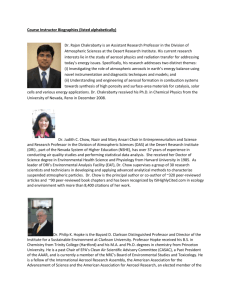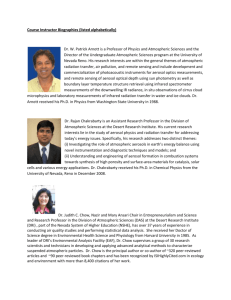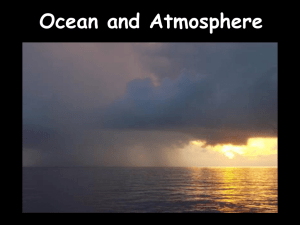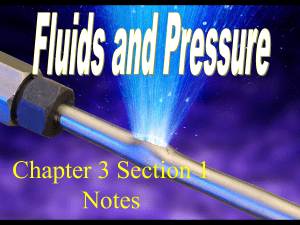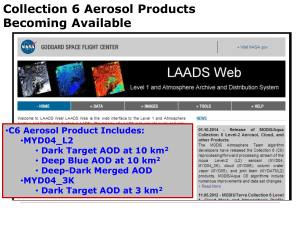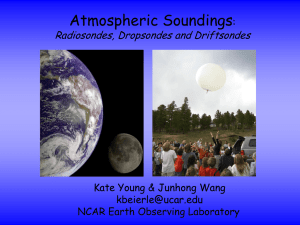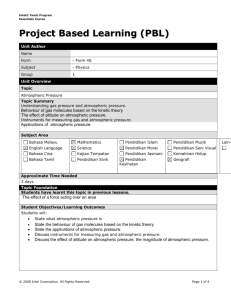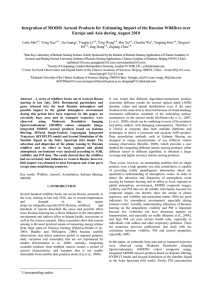Use of VIIRS Aerosol Products in a Regional Air Quality Model
advertisement
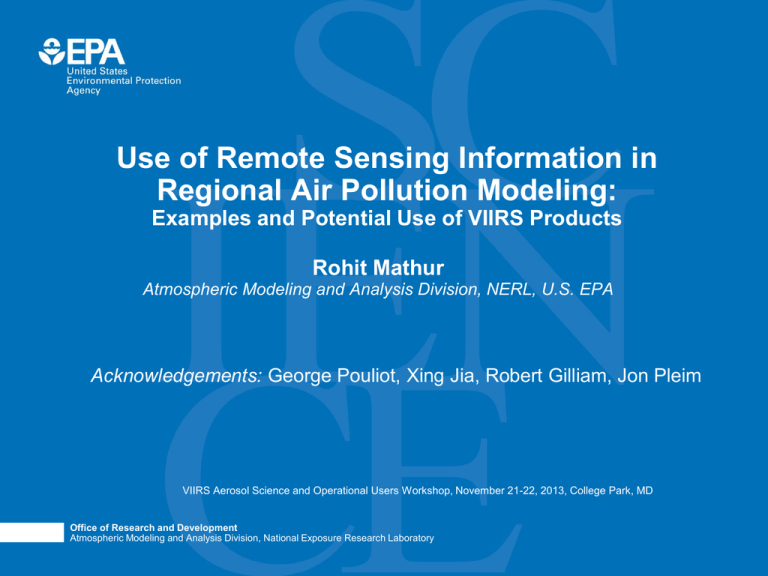
Use of Remote Sensing Information in Regional Air Pollution Modeling: Examples and Potential Use of VIIRS Products Rohit Mathur Atmospheric Modeling and Analysis Division, NERL, U.S. EPA Acknowledgements: George Pouliot, Xing Jia, Robert Gilliam, Jon Pleim VIIRS Aerosol Science and Operational Users Workshop, November 21-22, 2013, College Park, MD Office of Research and Development Atmospheric Modeling and Analysis Division, National Exposure Research Laboratory Motivation • Applications of regional AQ models are continuously being extended to address pollution phenomenon from local to hemispheric spatial scales over episodic to annual time scales • The need to represent interactions between physical and chemical processes at these disparate spatial and temporal scales requires use of observational data beyond traditional surface networks Office of Research and Development Atmospheric Modeling & Analysis Division, National Exposure Research Laboratory 2 Use of Remote Sensing Information in Regional AQMs • Evaluation/Verification of model results – High spatial resolution over large geographic regions of remote sensing data is attractive • Improve estimates of model parameters – Emissions (e.g, wildland fires, trends/accountability) – Key meteorological parameters (e.g., SST) – Lateral Boundary conditions (LRT effects) – Location and effects of clouds (e.g., photolysis) • Chemical data assimilation – Improving short-term air quality forecasts – Identification of model deficiencies • Data Fusion/Reanalysis: combining model and observed fields – For use in health, exposure and ecological studies (2012 NRC Report on Exposure Science in the 21st Century) Office of Research and Development Atmospheric Modeling & Analysis Division, National Exposure Research Laboratory Improving Model Parameter Estimates: Fire Emissions Courtesy: A. Soja Surface PM2.5 : June 10-17, 2008 Observed No Fire NEI-Smartfire New Estimate Fire detects have greatly helped with more accurate spatial allocation of emissions, but challenges remain: • Injection height/vertical distribution • Emission factors (the new approach used soil carbon content) • Ground fire detection Office of Research and Development Atmospheric Modeling & Analysis Division, National Exposure Research Laboratory Courtesy: George Pouliot 4 Diagnosing Model Performance Significant under-estimation: July 19-24 Large under-estimation (>2x) in OC in mid-July Office of Research and Development Atmospheric Modeling & Analysis Division, National Exposure Research Laboratory 5 Evidence of Long-range transport from outside the modeled domain Model picks up spatial signatures ahead of the front, but under-predictions behind the front (LBCs) Further Evidence 7/13/04 7/14/04 7/15/04 7/16/04 Long Range Transport of Alaskan Plume 7/17/04 Distribution of measured carbonaceous aerosol at STN sites within domain Regional enhancement in TCM on July 17-20 suggests influence of wildfires on air masses advected into the domain Office of Research and Development Atmospheric Modeling & Analysis Division, National Exposure Research Laboratory 7 Estimating the Impacts of Alaskan fires through Assimilation of Satellite AOD Retrievals Methodology 1. Model based correlation between AOD and column PM burden (July-August, 2004 data): – [PM]Col.Burden = f(AOD) • [PM]col. Burden = 9.065 AOD + 0.18 (r2 =0.9) 2. Estimate inferred PM2.5 burden: – [PM]infer = f(AODMODIS) 3. Estimate Difference in PM mass loading: – [PM]infer – [PM]BaseModel Adjust Model Initial Conditions 16Z on July 19, 2004 Distribute PM2.5 mass difference vertically between predefined altitudes 4. • Above BL: 2.2 – 4 km (based on Regional East Atmospheric Lidar Mesonet (REALM) data); layers 14-16 Speciation: EPA AP-42 emission factors for wildfires: OC 5. (77%), EC(16%), SO42- (2%), NO3- (0.2%), Other(4.8%) • CO/PM2.5 = 10 Office of Research and Development Atmospheric Modeling & Analysis Division, National Exposure Research Laboratory Mathur, 2008 (JGR) 8 Representing the 3D Transport Signature of the Alaskan Plume CO Comparisons with NASA DC-8 Measurements during ICARTT Assim-Base; 1700Z Enhanced CO associated with concurrently enhanced acetonitrile (CH3CN) – chemical marker for BB Assimilation helps improve the model predicted CO distributions July 19-23, 04 Impact on Surface PM2.5 Model Performance • Reduced Bias/Error • Improved Correlation July 20, 04 STN AIRNOW MODIS AOD Assimilation: Domain median surface levels enhanced by 23 - 42% due to Alaskan fires on different days Office of Research and Development Atmospheric Modeling & Analysis Division, National Exposure Research Laboratory 10 Air Quality – Climate Interactions Establishing Confidence in Simulated Magnitude and Direction of Aerosol Feedbacks • Large changes in emissions and tropospheric aerosol burden have occurred over the past two decades – Title IV of the CAA achieved significant reductions in SO2 and NOx emissions – Large increase in emissions in Asia over the past decade 1989-1991 2007-2009 • Is the signal (magnitude and direction) detectable in the observations? 50 aerosol loading and associated radiative effects? • Can the associated increase in surface solar radiation be detected in the measurements (“brightening effect”) and be used to constrain model results? SO2 annual emission (Tg) • Can models capture past trends in US China OECD+Central Europe 40 30 20 10 0 1990 1995 2000 2005 Office of Research and Development Atmospheric Modeling & Analysis Division, National Exposure Research Laboratory 11 Air Quality – Climate Interaction Trend in Aerosol Optical Depth (AOD) 2000 JJA-average MODIS+ SeaWiFS MODIS - level 3 Terra SeaWiFS - level 3 Deep Blue Missing value in MODIS (mostly in Sahara Desert) was filled by SeaWiFS (550nm) WRF-CMAQ (sf) 533nm Office of Research and Development Atmospheric Modeling & Analysis Division, National Exposure Research Laboratory 2009 Trend in Aerosol Optical Depth (AOD) WRF-CMAQ(sf) MODIS+ SeaWiFS JJA-average (2009 minus 2000) East China from 1990 to 2009 East US Europe Trend in clear-sky shortwave radiation JJA-average (2009 minus 2000) WRF-CMAQ(sf) WRF-CMAQ(nf) Dimming brightening CERES East China from 1990 to 2009 East US Europe Improving Model Parameter Estimates: Sea Surface Temperature July 1-31: GHRSST - PathFinder GHRSST RMSE Change T-2m Increase in Error Reduction in Error •1-km horizontal resolution global dataset • Daily RMSE and bias reduced with GHRSST. Reduction is even greater compared to NAM 12-km SST data. Implications for representing Bay Breeze and pollutant transport Office of Research and Development Atmospheric Modeling & Analysis Division, National Exposure Research Laboratory RMSE Change 63% Long-Range Transport and “Background” Pollution Levels • Added diagnostic tracers to track impact of lateral boundary conditions: surface-3km (BL) and 3km-model top (FT) – Quantify modeled “background” O3 Average: July-August, 2006 Modeled “background” O3 • Significant spatial variability “FT” contribution to model background • Background could constitute a sizeable fraction of more stringent NAAQS Accurate representation of aloft pollution critical for simulation of surface “background” Office of Research and Development Atmospheric Modeling & Analysis Division, National Exposure Research Laboratory Representing Impacts of Long-Range Transport Transport of Saharan Dust: Summer 2006 Texas Sites Surface PM concentration in the Gulf states impacted by LRT during July 30-Aug 3 Regional Model Driven by Hemispheric LBCs Dust Transport: 850 mb Office of Research and Development Atmospheric Modeling & Analysis Division, National Exposure Research Laboratory 17 Representing Impacts of Long-Range Transport Impact on Model Performance: July 30-August 3, 2006 Bias Difference: Base LBCs Hemis. LBCs Lower bias in Hemis. Lower bias in Base Vertically varying (time-dependent) LBCs are needed to accurately quantify impacts of LRT on episodic regional pollution as well as “background” pollution Office of Research and Development Atmospheric Modeling & Analysis Division, National Exposure Research Laboratory 18 Summary • Air quality remote sensing data is useful for model evaluation and improvements – What level of quantitative agreement is acceptable? – Need for harmonization between assumptions used in retrieval and CTM process algorithms (e.g., AOD, NO2 columns) for more rigorous quantitative use • Columnar distributions are a good starting point, but there is a need for better vertical resolution – Discern between BL and FT • Measurements to characterize transport aloft (and subsequent downward mixing next morning) are needed • Improving the characterization of FT predictions in regional AQMs will result in improvements in surface-level predictions • Potential for use in chemical data assimilation – Simultaneous information on multiple chemical species – Combining model and observed information on the chemical state of the atmosphere has potential for both human-health and climate relevant endpoints Office of Research and Development Atmospheric Modeling & Analysis Division, National Exposure Research Laboratory 19
